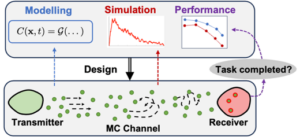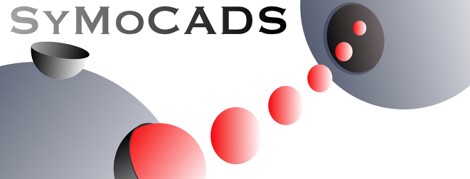Project P10 (Cross-Cluster)
P10: Task-oriented and Environment-dependent Modelling, Analysis, and Design of MC Systems

Motivation and state of the art:
Similar to natural MC systems, synthetic MC systems cover different length scales, exploit different molecule transport mechanisms, and operate in different environments1-6. For natural MC systems, the evolution of strategies for efficient information representation, transmission, and reception is influenced by the environmental conditions7,8. For synthetic MC systems9-13, the impact of the environmental conditions on the most favourable communication strategy has not been studied in detail and is not well understood. Furthermore, the existing MC literature has focused on Shannon-type performance metrics, such as transmission capacity and achievable transmission rate14,15, which do not take into account the context and purpose of the information exchange. In contrast, natural MC systems typically operate task oriented, i.e., they communicate to achieve one specific objective. For example, during quorum sensing, bacteria communicate with the objective to determine the most effective survival strategy16. Task-oriented concepts, such as identification capacity17-19 and semantic communication20-22, are receiving increasing attention for the design of conventional communication systems. In the identification problem, the receiver is interested in only one message (rather than in all messages as in Shannon’s transmission problem) from the set of possible messages, e.g., indicating that a certain event has occurred17. In semantic communication, the objective is to convey the correct meaning of a message in a certain context (rather than just symbols as in Shannon’s transmission problem) in order to accomplish a certain task20,21. Semantic codes and semantic information have been studied in the biological literature in the context of cell biology and genetics23,24. However, for task-oriented synthetic MC systems, initial results have been reported only recently25-28, and a comprehensive analysis and design framework is not available, yet. Related to this, although in many natural and synthetic MC systems analog molecular signals are relevant, e.g., the concentration of drug molecules in a certain target area29-31, motivated by the evolution of traditional communication systems, with the exception of 32, the MC literature has focused on digital modulation. Due to the large diversity of MC systems in terms of length scale, transport mechanism, propagation environment, context and purpose of communication, and applications, most of the existing works have taken a myopic view and study one specific MC system, similar to C1, C2, C3. However, from a more holistic and fundamental perspective, an important question is what implications the environmental conditions and the overall context of the communication have on the most efficient method for conveying information via molecular signals. The insights gained from such a fundamental study can help improve information transmission in synthetic MC systems, including those considered in C1, C2, C3, and serve as basis for new design strategies and applications. Furthermore, for the analysis and design of synthetic MC systems operating under different environmental conditions and for the development of novel task-oriented signalling schemes, simple yet sufficiently accurate analytical modelling and simulation tools are indispensable. However, the impact of the length scale, molecule transport mechanisms, propagation environment, and communication context on the design of analytical and simulative modelling techniques has not been comprehensively investigated so far.
Objectives:
This project has three main objectives:
(i) We intend to unveil the impact of the environmental conditions on the efficient representation of information via molecular signals.
(ii) We plan to investigate appropriate performance metrics and design strategies for task-oriented MC systems.
(iii) Hand in hand with (i) and (ii), we will develop multi-scale analytical modelling and simulation techniques for MC systems operating under different environmental and contextual conditions.
The project will closely interface with doctoral projects P1-P9 with the goal to unveil conceptual synergies and differences between the MC systems considered in clusters C1, C2, C3 and to guide possible extensions thereof.
References
1.Lotter, L. Brand, V. Jamali, M. Schäfer, H. Loos, H. Unterweger, S. Greiner, J. Kirchner, C. Alexiou, D. Drummer, G. Fischer, A. Buettner, and R. Schober, “Experimental Research in Synthetic Molecular Communications — Part I: Overview and Short-Range Systems,“ accepted for publication in IEEE Nanotechnol. Mag., [online] https://arxiv.org/pdf/2301.06417.pdf, Apr. 2023.
2.Lotter, L. Brand, V. Jamali, M. Schäfer, H. Loos, H. Unterweger, S. Greiner, J. Kirchner, C. Alexiou, D. Drummer, G. Fischer, A. Buettner, and R. Schober, “Experimental Research in Synthetic Molecular Communications — Part II: Long-Range Communication,“ accepted for publication in IEEE Nanotechnol. Mag., [online] https://arxiv.org/pdf/2301.06417.pdf, Apr. 2023.
3.V. Jamali, A. Ahmadzadeh, W. Wicke, A. Noel, and R. Schober. Channel Modeling for Diffusive Molecular Communication—A Tutorial Review, Proc. IEEE, vol. 107, pp. 1256-1301, Jul. 2019.
4.Akyildiz, F. Brunetti, and C. Blazquez, “Nanonetworks: A New Communications Paradigm,” Comp. Netw., vol. 52, pp. 2260-2279, Nov. 2008.
5.N. Farsad, B. Yilmaz, A. Eckford, C. Chae, and W. Guo. “A Comprehensive Survey of Recent Advances in Molecular Communication,” IEEE Commun. Surv. Tutor., vol. 18, pp. 1887-1919, Thirdquarter 2016.
6.Nakano, M. Moore, F. Wei, A. Vasilakos, and J. Shuai, “Molecular Communication and Networking: Opportunities and Challenges,” IEEE Trans. NanoBiosci., vol. 11, pp. 135-148, 2012.
7.Dressler and O. Akan, “A Survey on Bio-inspired Networking,” Comp. Netw., vol. 54, pp. 881-900, 2010.
8.Camazine, J.-L. Deneubourg, N. Franks, J. Sneyd, G. Theraula, and E. Bonabeau. Self-Organization in Biological Systems, Princeton University Press, 2003.
9.S. Kuran, H. Yilmaz, I. Demirkol, N. Farsad, and A. Goldsmith, “A Survey on Modulation Techniques in Molecular Communication via Diffusion,” IEEE Commun. Surv. Tutor., vol. 23, pp. 7-28, 2021.
10.Lu, M. Higgins and M. Leeson, „Comparison of Channel Coding Schemes for Molecular Communications Systems,“ IEEE Trans. Commun., vol. 63, pp. 3991-4001, Nov. 2015.
11.Martins, J. Drohan, S. Foley, L. Coffey, and S. Balasubramaniam, “Modulated Molecular Channel Coding Scheme for Multi-Bacterial Transmitters,” in Proc. 19th ACM Conf. Embed. Netw. Sens. Sys., pp. 610-615, 2021.
12.Kuran, H. B. Yilmaz, T. Tugcu, and I. Akyildiz, „Modulation Techniques for Communication via Diffusion in Nanonetworks,“ in Proc. IEEE Int. Conf. Commun., Kyoto, Japan, pp. 1-5, 2011, 2011.
13.Bhattacharjee, M. Damrath, L. Stratmann, P. Hoeher, and F. Dressler, “Digital Communication Techniques in Macroscopic Air-Based Molecular Communication,“ IEEE Trans. Mol. Biol. Multi-Scale Commun., vol. 8, pp. 276-291, Dec. 2022.
14.Aminian, M. Farahnak-Ghazani, M. Mirmohseni, M. Nasiri-Kenari, and F. Fekri, „On the Capacity of Point-to-Point and Multiple-Access Molecular Communications With Ligand-Receptors,“ IEEE Trans. Mol. Biol. Multi-Scale Commun., vol. 1, pp. 331-346, Dec. 2015.
15.Pierobon and I. F. Akyildiz, „Capacity of a Diffusion-Based Molecular Communication System With Channel Memory and Molecular Noise,“ IEEE Trans. Inf. Theory, vol. 59, pp. 942-954, Feb. 2013.
16.Waters and B. Bassler, “Quorum Sensing: Cell-to-Cell Communication in Bacteria,” Annu. Rev. Cell Develop. Biol., vol. 21, pp. 319-346, Jun. 2005.
17.Ahlswede and G. Dueck, „Identification via Channels,“ IEEE Trans. Inf. Theory, vol. 35, pp. 15-29, Jan. 1989.
18.Han and S. Verdu, „New Results in the Theory of Identification via Channels,“ IEEE Trans. Inf. Theory, vol. 38, pp. 14-25, Jan. 1992.
19.Bracher and A. Lapidoth, „Identification via the Broadcast Channel,“ IEEE Trans. Inf. Theory, vol. 63, pp. 3480-3501, Jun. 2017.
20.Weaver, “Recent Contributions to the Mathematical Theory of Communications,” The Mathematical Theory of Communications, pp. 1-16, 1949.
21.Bao, et al., „Towards a Theory of Semantic Communication,“ in Proc. IEEE Netw. Sci. Workshop, pp. 110-117, 2011.
22.Qin, Zhijin, X. Tao, J. Lu, W. Tong, and G. Li, “Semantic Communications: Principles and Challenges,” submitted for publication, [online] https://arxiv.org/pdf/2201.01389.pdf, 2022.
23.Görlich, S. Artmann, and P. Dittrich, “Cells as Semantic Systems,” Biochim. Biophys. Acta – Gen. Subj., vol. 1810, pp. 914-923, 2011.
24.Stano, “Exploring Information and Communication Theories for Synthetic Cell Research,” Front. Bioeng. and Biotech., vol. 10, pp. 1-6, 2022.
25.Magarini and P. Stano, “Synthetic Cells Engaged in Molecular Communication: An Opportunity for Modelling Shannon- and Semantic-Information in the Chemical Domain,” Front. Commun. Netw., vol. 2, pp. 1-7, 2021.
26.Ruzzante, L. Del Moro, M. Magarini, and P. Stano, “Synthetic Cells Extract Semantic Information from their Environment,” in Proc. 6th Workshop Mol. Commun., Warwick, UK, 2022.
27.Salariseddigh, U. Pereg, H. Boche, C. Deppe, and R. Schober, „Deterministic Identification Over Poisson Channels,“ in Proc. IEEE Global Commun. Conf., pp. 1-6, 2021.
28.M. Salariseddigh, V. Jamali, U. Pereg, H. Boche, C. Deppe, and R. Schober, “Deterministic Identification For MC ISI-Poisson Channel,” accepted for presentation at IEEE Intern. Conf. Commun., [online] https://arxiv.org/pdf/2211.11024.pdf, 2023.
29.Farsad, B. Yilmaz, A. Eckford, C. Chae, and W. Guo. “A Comprehensive Survey of Recent Advances in Molecular Communication,” IEEE Commun. Surv. Tutor., vol. 18, pp. 1887-1919, Thirdquarter 2016.
30.U. Chude-Okonkow, et al., “ Molecular Communication and Nanonetworks for Targeted Drug Delivery: A Survey,“ IEEE Commun. Surv. Tutor., vol. 19, no. 4, pp. 3046-3096, Forthquarter 2017.
31.Unterweger, R. Tietze, C. Janko, J. Zaloga, S. Lyer, S. Durr, N. Taccardi, O.M. Goudouri, A. Hoppe, D. Eberbeck, D.W. Schubert, A.R. Boccaccini, and C. Alexiou, “Development and Characterization of Magnetic Iron Oxide Nanoparticles With a Cisplatin-bearing Polymer Coating for Targeted Drug Delivery,” Int. J. Nanomedicine, vol. 9, pp. 3659-3676, Aug. 2014.
32.Akkaya and T. Tugcu, “Analog Molecular Communication in Nanonetworks,” Bio-Insp. Models Netw. Inform. Comp. Sys., vol. 103, pp. 171-182, Springer, 2012.
